2023 Science Highlights
Time Domain Studies and Fundamental Physics
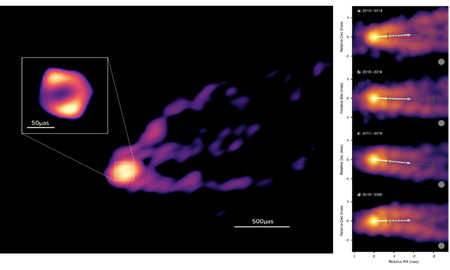
The NRAO facilities are critical for imaging Super Massive Black Holes (SMBH) down to scales of the general relativistic shadow of the SMBH. The latest result on the SMBH in M87 (Figure 1; Cui et al. 2023) from global VLBI at 3.5mm, anchored by the VLBA, ALMA, and the GBT, shows a 64µas diameter asymmetric ring, or 8.4Rs, similar to that seen at 230 GHz by the EHT, but larger in radius by about 50%. The observations also, for the first time, trace the jet down to this ring, possibly indicating a wind driven by the accretion disk. The difference in the M87 ring radius at 90 GHz vs 230 GHz remains a puzzle. Regardless, the fact that the Global 3mm VLBI Array (GMVA) can resolve such a ring, and trace the ring-disk connection down to scales of a few Rs, opens a new window of opportunity for the ngVLA to contribute to future global VLBI experiments at 90GHz, providing dramatic improvements in both the uv-coverage and the total collecting area. Including the ngVLA in the GMVA provides baselines that can image structures from 50µas to 50” at 90 GHz. The VLBA has also recently shown a precessional period of 11 years for the M87 jet, consistent with a spinning black hole that induces the Lense-Thirring precession of a misaligned accretion disk.

The NRAO facilities also played a major role in the remarkable discovery of a background of low frequency (nanohertz) gravitational radiation, likely arising from merging supermassive black holes distributed throughout the Universe, with a possible contribution from cosmic structure formation during the inflationary epoch, within 10-32 seconds of the Big Bang. The North American Nanohertz Observatory for Gravitational Waves (NANOGrav; Figure 2; Agazie et al. 2023) project is a pulsar timing array, comprised of radio telescopes that monitor millisecond pulsars distributed across the Galaxy. Passage of large scale gravitational waves bend space time between these pulsars and the Earth, leading to a characteristic spatial and temporal signature in timing residuals on yearly timescales for the pulsar distribution. The GBT and Arecibo were the primary telescopes involved, with an important contribution from the VLA for low declination pulsars. These results are yet another extraordinary contribution by radio astronomy to our understanding of general relativity and cosmology.
The VLASS is the state-of-the-art survey of the faint, time variable radio sky. One recent discovery from the VLASS was an extreme radio flare from a likely Tidal Disruption Event (TDE)— the disruption of a star as it falls into a SMBH, in a Seyfert galaxy at z = 0.074. The radio data include a factor of 100 brightening over a decade, suggesting the formation of a relativistic radio jet over a few years, while X-ray and IR data imply the coeval development of an accretion disk. These data provide further evidence for a fundamental relationship between the formation of relativistic jets and Active Galactic Nuclei (AGN) accretion disks (Somalwar et al. ApJ, 2023, 945, 142).
Time domain and ultra-high resolution large programs continue at the VLBA for synoptic imaging of powerful radio jets, including the Monitoring Of Jets in Active Galactic Nuclei with VLBA Experiments (MOJAVE) program on radio AGN, and the Blazars Entering the Astrophysical Multi-Messenger Era (BEAM-ME) program targeting Blazars, likely to be the sources of extragalactic neutrinos. The VLA has programs geared toward studying the electromagnetic counterparts to gravitational wave sources.
Solar System and Planetary Science
The NRAO facilities remain the paramount tools of radio astronomy in the study of planetary science and Solar physics. Working in concert with space missions and ground-based facilities, the VLA, ALMA, and VLBA have contributed in the last year in areas ranging from the energy source of the Solar chromosphere, to winds, storms, and polar vortices in the atmospheres of Saturn, Uranus, Neptune, and Jupiter, to the surfaces of Kuiper belt objects and volcanos on Io.
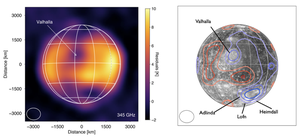
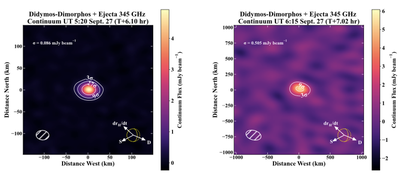
ALMA played an important role as a ground facility in the Double Asteroid Redirection Test (DART; Figure 4; Roth et al. 2023)— a deep space probe designed to investigate the effect of satellite impact on asteroid orbits, as part of the kinetic impactor planetary defense technique program at NASA. ALMA detected thermal emission from the asteroid at 345 GHz both before and after impact. The comparison of the two observations provide the most sensitive measurement of mm-sized ejecta caused by the impact. Depending on the material composition, the ejecta mass was ~ few x107 kg, representing about 1% of Dimorphos’ total mass.
Star and Planet Formation and Evolution, and the Search for Life

The NRAO facilities are uniquely suited for the study of stars, star formation, and planet formation. ALMA and the VLA remain the primary tools for imaging planet formation in proto-planetary disks, while the VLBA has produced the first images of what are likely aurorae and radiation belts associated with a low mass brown dwarf, possibly indicating strong star-planet interaction.
Magnetic fields play an important role in star formation, but direct measurements remain scarce. The VLA has demonstrated a new method to measure magnetic fields in star forming clouds using the Zeeman effect in the 38.3 and 38.5 GHz Class II methanol (CH3OH) masers (as opposed to the classic 6.7 GHz methanol masers). Zeeman measurements of the massive star forming region NGC 6334 find magnetic fields in the range 8 to 46 mG. Since Class II methanol masers are radiatively pumped close to the protostar, occurring in the accretion disk or the interface between the disk and outflow regions, such fields have significant impact on the dynamics of these disks (Figure 5; Momjian and Sarma 2023).
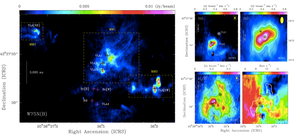
ALMA has observed the star-forming region W75N(B), containing the massive protostars VLA1, VLA2, and VLA3. VLA2 is an enigmatic protostar associated with a wind-driven H2O maser shell, which has evolved from an almost isotropic outflow to a collimated one in just 20 years, with the shell expansion halted by an obstacle located to the northeast. ALMA observations of the 1.3 mm continuum and H2CO and SiO emission show a region of ∼30” (∼39,000 AU) diameter, with 40 compact continuum sources, including VLA1, VLA2, and VLA3. The H2CO emission is mainly distributed in a fragmented structure around the three massive protostars. The SiO is highly concentrated on VLA2, indicating the presence of very strong shocks generated near this protostar. The SiO emission is resolved into an elongated structure (0.6”x 0.3”) perpendicular to the major axis of the wind-driven maser shell. The structure and kinematics of the SiO emission are consistent with a toroid and a wide-angle outflow surrounding a central mass of ∼10 M⊙, thus supporting previous theoretical predictions regarding the evolution of the outflow (Figure 6; Gomez et al. 2023).
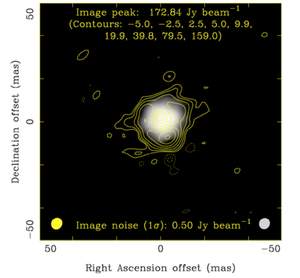
R Lep is a Mira-type Red Giant variable star, with a period of 445 days at a distance of 471 pc (Figure 7; Asaki et al. 2023). ALMA was used in 2021 to image the carbon-rich evolved star in Bands 8–10 (397–908 GHz) with baselines up to 16 km. The goal was to validate the calibration, using band-to-band phase referencing with a close phase calibrator. Diffraction limited resolution images were made up to the highest frequencies with resolutions of 5mas, thereby demonstrating the potential for ALMA to perform very high resolution imaging with the longest baselines at the highest frequencies.
The ALMA large program Complex Organic Molecules in Protostars with ALMA Spectral Surveys (COMPASS) is in progress to study complex organic chemistry in star and planet forming regions, while the ALMA survey to Resolve exoKuiper belt Substructures (ARKS) program is targeting exo-Kuiper belt dust emission.
Galaxies and Galaxy Formation
ALMA and the VLA are primary tools for studying the molecular gas out of which stars form throughout the Universe, while the ultra-high resolution of the VLBA can probe radio structures down to sub-parsec scales in the most distant galaxies.
The VLA and VLBA have observed HI 21cm absorption toward the radio galaxy 3C84 (Figure 8; Morganti et al. 2023), at the center of the rich Perseus cluster of galaxies. Broad HI 21cm absorption is detected (500 km/s) with the VLA toward the nucleus at arcsec resolution. The line width suggests that the detected gas is close to the SMBH, but no absorption is detected with the VLBA at 7 mas resolution. Comparison with the circum-nuclear disk (CND) seen in CO emission with ALMA, shows similar velocity and spatial structure, suggesting the HI is associated with the fast rotating CND down to 20 parsec radius. The radio continuum providing the background for absorption arises from non-thermal synchrotron emission from the star formation activity in the CND, whose presence has been reported by earlier VLBA studies.

Multifrequency VLA observations of the prototype Fanaroff-Riley (FRI) radio galaxy, Hydra A (Figure 9; Baidoo et al. 2023), reveal extreme Faraday rotation measures (RM), with magnitudes as large as -12300 rad m−2, the majority of which arises in the magnetized thermal cluster gas. The radio emission also depolarizes systematically with decreasing frequency and decreasing resolution. These results can be modeled by a Faraday screen of magnetized cluster gas, external to the radio lobes, with field strengths of a few mG, and with both large scale ordered fields on tens of kiloparsec scales, plus turbulent field structures down to scales of 1 kpc, or less. Such fields have important implications on cluster thermal conductivity and turbulence.

One of the most impressive results from JWST has been the discovery of ultra-high-z galaxies, out to z ~ 16, or a look-back time of 13.5 Gyr (the Big Bang occurred 13.7 Gyr ago). The mere existence of these ultra-redshift galaxies presents an interesting challenge to models of galaxy formation and cosmology. ALMA provides the unique ability to image the gas and dust in these first galaxies. ALMA is now regularly detecting fine structure line emission from z ~ 8 to 10 galaxies, revealing gas physical conditions, distribution, and dynamics, complimenting JWST studies of the stars and gas. For the current JWST redshift record holder, a candidate galaxy at zphot ~ 16, a tantalizing spectral feature seen with ALMA may be [OIII] 52um emission at this redshift, but requires confirmation, since it could be [CII] 157 um emission at z = 4.6. Study of the gas and dust in the ultra-high redshift universe promises to become a major growth area for ALMA in the coming years (Figure 10; Fujimoto et al. 2023).
![Figure-01-01-04-03.png Figure 10. Top: images of dust continuum (non-detection), possible [OIII] 88um emission, and the JWST near-IR image of a z ~ 16 JWST galaxy candidate (Fujimoto ea. 2023, ApJ, 955, 130). Bottom: ALMA spectrum.](https://science.nrao.edu/science/highlights/images/2023/Figure-01-01-04-03.png/@@images/45b66f6d-849a-45ee-a20e-72b5cc28f28c.png)
The VLBI has observed M81*, one of the closest low-luminosity active galactic nuclei, at 8.8, 22, and 44 GHz. A bright knot in the core-jet is seen at 1.2mas distance (0.023 pc) from the core. Multi-epoch observations show that the knot has a low apparent speed of 0.1c. X-ray observations show a moderate X-ray flare occurred when the knot launched from the core region. Three possible origins are currently possible: an episodic jet ejection, a low-speed shock wave, or a possible secondary black hole in a binary system (Figure 11; Wang et al. 2023).

The first results from the Physics at High Angular Resolution in Nearby GalaxieS (PHANGS) large program at ALMA have appeared, which, in concert with the JWST, has produced spectacular images of the relationship between the molecular gas, dust, stars, and star formation down to tens of parsec scales in a large sample of nearby galaxies. At higher redshift, the ALMA Large Proposal of gAlactic Cold gAs (ALPACA) program is probing the molecular gas in a large sample of galaxies at the peak epoch of galaxy formation, z ~ 1.




Connect with NRAO